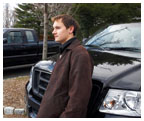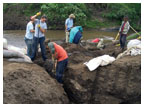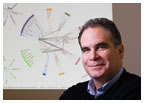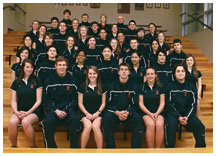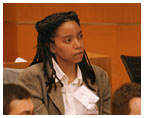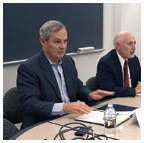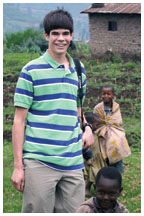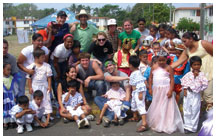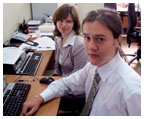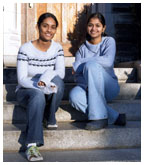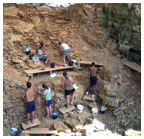
|
January 24, 2007: Features
The
international campus
More and more, Princeton goes global
By P.G. Sittenfeld ’07
The heart of the Princeton campus isn’t likely to move from central New Jersey anytime soon. But a large — and rapidly increasing — portion of the Princeton experience already is occurring far beyond FitzRandolph Gate. Students today have greater access to international service trips, research projects, and language programs than ever before, and President Tilghman has strongly encouraged all undergraduates to take advantage of them. The ultimate goal, according to Miguel Centeno, professor and director of the Princeton Institute for International and Regional Studies (PIIRS), which oversees and helps fund many of the initiatives abroad, is for every student to graduate having had an international experience. Meanwhile, the campus itself has become more worldly, attracting greater numbers of international students and expanding its curriculum to focus on previously neglected places and cultures. In short, the Orange Bubble — as students still enjoy referring to their cozy, insular surroundings — is bursting.
 Princeton-Oxford
exchange
Princeton-Oxford
exchange
Along with everything Oxford University exchange student Chris Pritchard has learned in his classes, he received an introduction to Americans’ love for big cars. (Hyunseok Shim ’08) |
Chris Pritchard knew he was in America after his first close encounter with an oversized SUV. “We found a car that had a bonnet [Brit-speak for an auto hood] taller than I am,” says Pritchard, one of 11 students from Oxford University enrolled in a special four-year-old exchange program with Princeton. “I could have had a Ford logo pressed into my forehead!”
The largest of Princeton’s undergraduate exchange programs — seven Princeton students were at Oxford in the fall — the Oxford exchange gives students from both schools a chance to experience life on the opposite side of the pond. Some students enroll in undergraduate courses; others conduct graduate-level research. Audrey Banks ’07, who spent the last academic year studying history at Oxford, regularly enjoyed activities running the gamut from punting to pub-hopping to Shakespearean productions in the college quads.
Participants say the schools have plenty in common — starting with first-rate academics. “Intellectually, I felt profoundly satisfied while I was there,” Banks says. “You pour yourself into the work because of their tutorial system.” The common ground extends to the broader campus culture. “Princeton’s quite a bubble — same as Oxford,” observes Lucy Thorne, who is living the Old Nassau life this semester while doing research in biochemistry.
Students acknowledge, however, that the change of scenery spotlights as many differences as similarities. “At Oxford, we’ve got everything you could ever associate with old but not as much money,” says John Gartside, who is visiting Princeton for the year to study electrical engineering. “Princeton’s got all this money, but then you just use it to build stuff that looks as old as ours.”
One aspect of American culture the visiting Brits have not yet embraced is the food. “Everything’s greasy,” Thorne grouses. “Even your veggies are cooked in butter.”
![]() Engineers Without Borders
Engineers Without Borders
Princeton students in Engineers Without Borders at work building an irrigation system in Ethiopia last summer. (courtesy Eric Hui ’09) |
When the Princeton students involved in Engineers Without Borders (EWB) test their engineering knowledge, the stakes register beyond their academic transcripts. The national nonprofit organization — of which Princeton has one of 70 college chapters — sends teams of students and professionals to developing and Third World countries to assist in implementing high-impact and often life-changing projects.
Princeton’s participants say that what they glean from these field projects is an invaluable addition to what they’re learning in the classroom. “I’d taken a civil engineering course all about concrete, but the first time I had to actually make it on my own was totally different,” says Andy Lapetina ’07, the president of Princeton’s chapter of EWB. Lapetina led a trip last summer to help build an irrigation system for a village near the Kumudo River in Ethiopia.
Princeton’s chapter also is involved in efforts to bring electricity to the small town of Huamanzaña, Peru. Nine undergraduates and one graduate student or professional engineer participate in each project for three to six weeks during the summer. Groups return to the same site for five consecutive years. The students on the Peruvian expedition spent last summer constructing solar panels on an elementary school, and will install efficient wood-burning stoves on their next trip.
“I remember when we first turned on some of lights we’d put in,” says Shannon Brink ’09, the project leader in Peru. “I looked over and saw an older member of the community with a single tear running down his cheek.”
Brink, who isn’t certain what she will major in, says her experience already has caused her to frame her studies as more than just abstract academic issues. “It’s made me re-evaluate the economics courses I’ve taken,” she says. “Something like free trade looks different when I think about how it might affect the friends I made in Peru.”
![]() Mapping globalization
Mapping globalization
Professor Miguel Centeno, director of the Princeton Institute for International and Regional Studies and creator of the Mapping Globalization Project. (Ricardo Barros) |
Globalization is a buzz word equally au courant inside and outside academic circles. Why has Halloween taken hold in Britain? Why are customer-service calls routinely routed to India? Why can travelers navigate most destinations in the world speaking only English? The standard response: “Well, that’s just globalization.”
But that answer doesn’t satisfy Miguel Centeno, director of the Princeton Institute for International and Regional Studies. “There’s an incredible amount of discussion about globalization, but very little of it is empirical,” Centeno says. “It’s not enough to just talk about it as this sweeping, nebulous phenomenon.”
Centeno believes globalization can — and should — be represented for what it really is: the cumulative effect of countless smaller transactions. In order to offer a sense of those transactions, Centeno has created the Mapping Globalization Project (http://qed.princeton.edu/MG), which he hopes will be useful for everyone from young students to accomplished scholars.
“There is little doubt that we are undergoing a process of compression of international time and space,” the site explains. “Lacking a coherent empirical or theoretical underpinning, the concept [of globalization] is in danger of becoming an academic ‘one-hit wonder’ with little to show for the attention.”
To provide that intellectual underpinning, Centeno’s site features a growing collection of digitized maps, narratives, and data sets that isolate individual facets of globalization. The narratives, aimed at younger age groups, are mini-movies showing important historical developments — for example, the ebb and flow of Alexander the Great’s empire or the spread of the Black Death through Europe. About 1,000 maps make wide-ranging historical transactions vivid through visual representation.
The most sophisticated element of the Mapping Globalization Project is the data sets. These offer scholars detailed information on everything from shifts in the world oil market to patterns of international terrorism.
This spring, Centeno will put the site to good use in a new sociology course about globalization. One-third of the class will focus on cartography, another third on statistics, and the final group on historiography. The three teams then will construct their own theories about what globalization means and how it actually occurs.
Where they come from
Top 10 countries of origin for Princeton’s international
students:
Undergraduates
Canada 137
China 45
South Korea 45
United Kingdom 44
Romania 19
India 14
Bulgaria 13
Mexico 13
France 12
Turkey 12
Graduate students
China 228
Canada 90
India 81
Germany 42
United Kingdom 37
South Korea 36
Turkey 31
Greece 26
France 25
Russian Federation 21
Full-court
press
The men’s and women’s squash teams — known for their international membership — pose on the bleachers in Jadwin Gymnasium. In the back row are, from left: Dent Wilkens ’07, a volunteer coach for the women’s team, men’s coach Robert Callahan ’77, women’s coach Gail Ramsay, and Neil Pomphrey, Callahan’s assistant and principal research physicist in the Princeton Plasma Physics Laboratory. (Beverly Schaefer) |
While many undergraduates seek cultural exposure by studying abroad, not all students can leave campus for half the school year. Athletes in particular, with the rigorous demands of year-round practices, are at the mercy of their sports schedules. But that doesn’t necessarily mean they forgo an international experience.
Several of Princeton’s athletic teams have large contingents of international students: The rugby team, for example, is anchored by a handful of Englishmen, and the ice hockey team depends heavily on our Canadian neighbors.
One group claiming a truly eclectic mix of nationalities is varsity squash. The women’s squad suits up players from such countries as Trinidad and Tobago and China, while the first five players in the men’s lineup hail respectively from Mexico, Malaysia, Egypt, El Salvador, and Hong Kong.
“I think the sport appeals to a more diverse cross-section of society in the rest of the world than it does in the States,” says Kimlee Wong ’08 of Malaysia.
Because the United States trails much of the world in squash talent — rarely do American men or women crack the top 50 in professional world rankings — Princeton recruits outside the country to stay competitive.
One exceptional athletic import was Yasser El Halaby ’06 of Egypt, who last year set a men’s intercollegiate record by winning his fourth consecutive individual squash championship.
Aside from compiling wins, team members say their international makeup helps preserve squash’s image as a gentleman’s sport: In moments of on-court frustration, players can mutter expletives in their mother tongue without being understood.
![]() Global
Network on Inequality
Global
Network on Inequality
Leslie Hinkson GS, center, received a fellowship to study in London through a new program that sends graduate students and faculty members to pursue research abroad. (John Jameson ’04/Office of Communications) |
When sociology professor Katherine Newman moved from Harvard to Princeton in 2004, her main concern was that she not leave anything behind — particularly the project she started in Cambridge in 2000 known as the Global Network on Inequality.
The network, which was launched in Princeton in 2005, consists of partnerships with 17 research institutions and university departments across Western Europe and Japan, where graduate students and faculty members can pursue research on aspects of inequality. Each year, the University sends seven to 10 graduate students concentrating in sociology, economics, or public affairs to foreign host institutions to participate in data analysis relating to issues including education, immigration, income, and race.
“It’s important to see how various countries treat the same issues differently,” Newman says. “Most of the students who participate want to have careers in the United States, but they’ll benefit from understanding the problems they’re interested in as they appear in other parts of the world.”
Fourth-year sociology graduate student Christine Percheski spent three months last spring at Germany’s University of Bremen studying how unemployment affects the age at which women have their first child. “I had access to data and to people with certain expertise that I otherwise wouldn’t have in the United States,” Percheski says.
China, Mexico, and South Korea are next on Newman’s list. “We’re studying the fundamental issues in inequality of our time while creating contacts with the next generations of scholars in other countries,” she says. “This is globalization in action in higher education.”
 Diplomatic
professors
Diplomatic
professors
Ambassador Robert Hutchings, left, and diplomat-in-residence Edmund Hull '71 lead a class on national intelligence in December. (Hyunseok Shim ’08) |
When Woodrow Wilson School students roam around Robertson Hall, it’s easy to understand why they sometimes feel they have stumbled into the State Department. The Wilson School has a tradition of importing diplomats and ambassadors to teach undergraduate and graduate courses.
Past notables include the Wilson School’s founding director and counselor to the U.S. Embassy in Berlin, Dewitt Clinton Poole, and former ambassador to the Soviet Union
Jack Matlock. Last year, Dean Anne-Marie Slaughter ’80 announced the Diplomat-in-Residence Program, which invites career government officials to lead courses on international security and diplomacy and provide career advice to students interested in the State Department.
The first diplomat-in-residence, Edmund Hull ’71, former U.S. ambassador to Yemen, is teaching an undergraduate class on national intelligence. “I’m not trying to duplicate the academic experience my colleagues offer as much as complement it with practical expertise,” Hull says.
Other recent additions to the faculty include former German foreign minister Joschka Fischer (see article on page 50) and Daniel Kurtzer, former ambassador to Egypt and Israel. Although Kurtzer served for two years as dean of Yeshiva College (part of Yeshiva University) in New York City before joining the State Department, he says he’s still acclimating to life inside the classroom: “This is all essentially brand-new to me, and it’s harder than you might think the first time you do it.” Kurtzer is teaching a graduate course on Jerusalem titled “The Contested City,” and advising three seniors on their theses.
“I think he’ll really be able to take me to task on my policy recommendations,” says Omar Raddawi ’07, one of Kurtzer’s advisees, who is writing about U.S. foreign policy toward Syria. Kurtzer agrees that he can offer a unique perspective. “A lot of people can teach Middle Eastern policy,” he says, “but I think it helps that I’ve lived it.”
![]() Learning
the language
Learning
the language
Mark Doramus ’09, pictured at a displaced-persons camp in Rwanda, is now studying Swahili. (courtesy Mark Doramus ’09) |
As much of the world commits to learning English, Princeton students are determined to be able to hold their own in other languages. The University offers courses in 17 foreign languages, of which Spanish, French, and Chinese attract the most students.
Two of the University’s newest language offerings are Swahili and Hindi. Many students say that they are looking for a change from the Romance languages they’ve been learning all their lives. “Swahili is so different from most other languages you’ll study,” says Mark Doramus ’09, a native of Little Rock, Ark., who studied Spanish before coming to college and is now in an introductory Swahili course.
Doramus became excited about Swahili after a trip to Kenya and Rwanda the summer before his freshman year. He’s now aiming for fluency — even if it has limited use in Arkansas. “I think I might represent just about the entire Swahili-speaking population of Little Rock,” Doramus says.
Advanced speakers, who either grew up speaking Swahili or have several semesters of study behind them, can take a Swahili literature course. Though students spend the semester reading Swahili novels, poetry, and plays, their moments of revelation aren’t always so literary. Katherine Anderson ’08 remembers one class when her professor said hakuna matata — a phrase that means “no worries” and was made famous in the United States by the film The Lion King. “Everyone in the class looked at each other like: Seriously? We had no idea it was an actual Swahili saying.”
While Doramus and Anderson both hope to use their Swahili skills in the future, Swati Antala ’09 has more urgent reasons for taking Hindi 101. Her family is traveling to India in the coming summer for a cousin’s wedding. “Hopefully now I won’t just have to be mute every time someone tries to talk to me,” Antala says.
Learning the language
Princeton offers instruction in 17 foreign languages. Here’s
how enrollment stacks up:
Spanish 782
French 478
Chinese 291
Italian 209
German 196
Arabic 135
Japanese 114
Latin 112
Portuguese 66
Russian 62
Greek 54
Hebrew 30
Swahili 30
Persian 25
Hindi 20
Korean 15
Turkish 13
Total 2,632
Source: Office of the Registrar
![]() The
Cruz Blanca Initiative
The
Cruz Blanca Initiative
Princeton students participating in the Cruz Blanca Initiative in Mexico last summer. The photo was taken after a traditional ceremony in which children dressed in costumes and danced and paraded through the town. Kush Parmar ’02, who created and led the first CBI trip, is pictured in the back row, third from left. (photos courtesy andrew turco ’07, left, and simion filip ’09, top )
|
Dancing a hip-hop routine for the host community isn’t a planned part of the Cruz Blanca Initiative (CBI), an annual student-run service trip to Mexico. But it is one sure way to win over the locals.
Every spring break eight students, and two student leaders who participated the previous year, journey to the site of their project. CBI began in 1999, when Kush Parmar ’02 created and led the first trip. Last summer, the CBI crew helped construct a one-room elementary school building in the town of Medellín. Thanks to fundraising efforts throughout the academic year, they also brought $15,000 to complete the project.
Workdays start early and aren’t easy. Without state-of-the-art construction equipment, tasks include shoveling dirt, sawing wood, and laying bricks and mortar. “It was an incredible feeling to see walls rise up and a foundation take form,” says Jessica Harrop ’08.
The trip is more than just toil, though. Participants take time to swap stories and play soccer with the schoolchildren. When talking with the children, little is lost in translation. During one pickup soccer game, a 10-year-old asked how long his American teammates had been playing the sport. Upon learning that many had been playing since age 5, he wondered aloud: “How come you’re not better by now?”
As part of the experience, hosts offer CBI participants the flavor of local customs by preparing traditional Mexican dishes and singing favorite songs. One year, the host community invited CBI participants to observe a funeral.
And as for that hip-hop routine? “They’d been sharing their culture with us all week, so we thought we’d do some performing for them,” explains Andrew Turco ’07, one of last year’s trip leaders. Though the dance was self-mockingly choreographed to the Backstreet Boys’ song “Everybody,” locals of all ages enthusiastically insisted on an encore.
 The
international office
The
international office
Simion Filip ’09, front, at work in the analytic department at Alfa Capital in Moscow last summer, with a co-worker. |
When Darcy Bradley ’07 arrived in Thailand last summer to begin her internship with the United Nations Intergovernmental Oceanic Commission, she had little sense of how substantive her experience would be. All she knew was that she was lucky.
Friends in American internships reported that they were stuck in jobs with little flexibility, “at the bottom of the totem pole,” she says. Bradley’s host organization had a different set of expectations. Upon arrival, she partnered with a professional molecular biologist and began developing ways to educate tourists about coral reef protection.
“I think they thought I had a research grant because I basically got to do whatever I wanted,” Bradley says. “They really trusted me to do good work and looked to me for opinions.”
Bradley’s internship in Thailand is one of nearly 50 offered by Princeton’s International Internship Program. Founded six years ago, PIIP allows students to spend their summer abroad in a professional environment. “There’s just as much focus on the professional aspect as on, say, learning the language,” says PIIP director Elena Uribe. “You might be able to skip class in a study-abroad program, but with these internships you need to behave like someone who works there permanently.”
Since most of the internships are unpaid, PIIP provides funding between $2,500 and $4,000. Positions are available in settings from Belgium to Sri Lanka to Botswana, and some students identify their own international opportunities.
Simion Filip ’09 spent last summer in Moscow working at Alfa Capital, one of the first investment banks to open in Russia. “They had me helping managers develop trading strategy,” Filip says. “I never expected to be doing such important stuff.”
![]() Princeton
in the world
Princeton
in the world
Seniors Sanhita Sen, left, and Ritu Kamal are starting a Princeton-in-India program. (Hyunseok Shim ’08) |
The prefix “Princeton-in” is popping up in front of more and more international destinations. Following the successful model of Princeton-in-Asia (now in its 108th year), the University created Princeton in Africa (2000) and Princeton in Latin America (2002) programs for postgraduate work experience.
While still undergraduates, students also can receive academic credit for any of six summer language programs: Princeton in Annecy (France), Beijing, Kanazawa (Japan), Macerata (Italy), Munich, and St. Petersburg.
“Being in Beijing was an amazing overstimulation of the senses and the mind,” says Bianca Bosker ’08, citing everything from the food to the pollution to the academic intensity of the program. She calls it “Chinese-language boot camp.”
Undergraduates are also encouraged to spend a semester abroad at universities or in study-abroad programs around the world. Associate Dean of the College Nancy Kanach says that nearly 100 students will be abroad for the spring semester, with England, France, and Hungary the top destinations (last year, the most popular destinations were England, South Africa, and Argentina). Eighteen institutions abroad have special affiliations with Princeton, including a brand-new exchange program with Seoul National University in South Korea.
What will be the next installment of Princeton-in-the-World? A team of undergrads led by Ritu Kamal ’07 and Sanhita Sen ’07 are wondering: Why not Princeton-in-India?
“Interest in India has really been growing in recent years,” says Sen, who points to the University’s recent addition of Hindi to the curriculum. “It’s the world’s largest democracy, yet Princeton-in-Asia doesn’t have any positions there.”
The goal, according to student organizers, is to begin with a small but sustainable program and grow from there. Princeton-in-India plans to send four graduating seniors to Delhi for yearlong fellowships beginning this summer. Fellows will work for nongovernmental organizations on issues related to AIDS, the environment, and women’s rights.
Supporters say India is an ideal place for students to continue their nonacademic education. “It’s a fascinating country at two different levels,” says electrical engineering professor Sharad Malik, who grew up in Delhi and is serving as a faculty sponsor. “On the one hand it’s this emerging economic force, but at the same time, it’s a developing country with a lot of social issues that students can help address.”
Who’s getting the doctorates?
Princeton doctorates awarded in 2006
U.S. citizens
Engineering 29
Humanities 36
Natural sciences 51
Social sciences (including WWS) 31
International students:
temporary residents
Engineering 48
Humanities 16
Natural sciences 38
Social sciences (including WWS) 27
International students:
permanent residents
Engineering 4
Humanities 4
Natural sciences –
Social sciences 1
Source: Office of the Registrar
![]() Research
for the adventurous
Research
for the adventurous
Undergraduates in professor Alan Mann’s summer anthropology course excavate in a Neanderthal fossil site in southwest France. (courtesy Alan Mann) |
Water metaphors abound come finals period: Students say that they’re just trying to stay afloat; that they’re drowning in paper assignments; that the situation is sink or swim!
Then there are the participants in Professor James Gould’s summer course in Bermuda on marine biology. For them, immersing themselves in their work environment comes with the territory. Much of the four-week course — for which students receive academic credit — consists of snorkeling, helmet diving, and underwater caving. Labs focus on topics such as coral ecosystems and fish breeding.
“I remember the information that we learned better because what we were doing was so hands-on,” says Charlotte Jones ’08, an ecology and evolutionary biology (EEB) major who took the course last summer. “When else would I be thigh-deep in mud in a mangrove swamp or swimming next to an upside-down jellyfish?”
Gould’s may be one of the more physically demanding courses, but other international field experiences are equally interesting. Among them: Anthropology professor Alan Mann leads a course on modern human origins in Bordeaux, France; art and archaeology professor William Childs ’64 oversees a digging expedition in Cyprus; and Wilson School professor Daniel Kurtzer took students in his graduate seminar on Jerusalem to Israel just before the start of the fall semester. There are Wilson School junior-year policy task forces in Oxford, England, and Cape Town, South Africa; an EEB semester-abroad field-research program in Panama; and a similar EEB program at the Princeton-affiliated Mpala Conservancy in Kenya. Next summer, the University will launch four six- to-eight-week seminars in Vietnam, Greece, South Africa, and Italy.
The experiences are not meant to be vacations. In Mann’s course,
students spend three weeks taking classes at the University of Bordeaux
before relocating to the small village of Marillac, where they spend six
days a week on an archaeological site excavating Neanderthal fossils.
Members of the Bermuda crew say they kept busy from 8 a.m. to 9 p.m.,
adding that they found themselves studying even when they did have downtime.
“Sometimes we’d be snorkeling just for fun but still be trying
to identify the different kinds of fish,” Jones says. ![]()
PAW columnist P.G. Sittenfeld ’07, from Cincinnati, will attend Oxford University next year on a Marshall Scholarship.

